
Greenland: Sled Crossing
Dog sledding is part of everyday life in icy Greenland, where you can’t even travel one town over by car. Because the topography of the land includes a high concentration of mountains and fjords, it’s impossible to build a full road system. The Indigenous Inuit people have been traveling by dog sled for centuries, and even have a specific breed of dog (appropriately, Greenland dogs) bred for the job. So it’s no wonder there’s a sign for when dog sleds are likely to be present. It’s a triangle with a bold red outline and a silhouette of a sled on it. There’s a similar sign for snowmobiles, which you’ll need if you don’t have access to a dog sled.

India: PEEP PEEP DON’T SLEEP
Border Roads Organisation (BRO) is an Indian government entity that maintains roads along the country’s border areas. BRO’s project Himank builds and maintains roads in the Ladakh region high up in the Himalayas, including the highest-altitude road in the world. But it’s not just the height that sets those roads apart — it’s the bright yellow stone signs with notoriously wacky safety slogans warning travelers against falling asleep at the wheel, driving drunk, and distracted driving. Examples include “AFTER WHISKY DRIVING RISKY,” “DRIVE ON HORSEPOWER, NOT RUM POWER,” “SAFETY ON THE ROAD, ‘SAFE TEA’ AT HOME,” and “PEEP PEEP DON’T SLEEP.” Slogans like “IF YOU SLEEP YOUR FAMILY WILL WEEP” are especially ominous.
Not all of the signs are about safety; some just offer general encouragement (“WHEN THE GOING GETS TOUGH, THE TOUGH GET GOING”) or dubiously attributed celebrity quotes (“WITHOUT GEOGRAPHY YOU’RE NOWHERE” — JIMMY BUFFETT).

Australia: Kangaroo Crossing
In Australia, kangaroos are involved in a significant number of animal-related accidents. In the state of New South Wales (NSW), where kangaroos roam even in urban areas, collisions are especially common — sometimes because a car hits a kangaroo, other times because a car swerves to miss a kangaroo. In a telephone survey of residents of Canberra — the capital of Australia, located in NSW — 17% of car owners reported some kind of kangaroo collision. Usually kangaroo crossing signs look like wildlife warning signs familiar in the United States and other countries, with a silhouette of a kangaroo on a yellow diamond. In some areas that see a lot of kangaroo collisions, the signs get bigger and brighter, and include a number to call in case of injured wildlife.
While kangaroo signs have never officially popped up in the United States, one prankster in North Carolina mounted an unofficial one in such a convincing way that it made the local news.
More Interesting Reads

Iceland: Public Hot Tub Ahead
Iceland is world-renowned for its weird, cute, and one-of-a-kind road signs, like a pretzel indicating the way to a bakery. (One northern town also has heart-shaped stop lights.) Even the country’s most logistical signage is a major target of theft because of the nation’s unique geography and the graphic design that warns of it — images of cars driving into water or bouncing on rough terrain are common.
Iceland’s roadside service markers are incredibly thorough, with little icons indicating everything from crossing divers (a person wearing a snorkel and flippers in a crosswalk) to dog hotels (a dog with a roof over its head). One particularly useful sign in Iceland’s cold climate lets drivers know of a nearby hot tub: It features a head emerging from water with a thermometer next to it. Sans thermometer, it means there’s a public pool nearby, which is still nice.

Newfoundland: Moose With Car Wreck
Moose crossing signs are present wherever moose are common, but they typically just have a silhouette of a moose, like other wildlife crossing signs. A national park in Newfoundland, Canada, has a different design — one that adds a sense of urgency.
Moose are not native to Newfoundland, and the first ones arrived relatively recently, in 1904. These giant creatures throw a wrench in the natural ecosystem, and the natural forests are having trouble regenerating as a result of excessive moose-snacking. Meanwhile, with abundant food and few predators, the moose are having a great time. As a result, there are way too many of them, and drivers run into them pretty frequently. Most of Newfoundland has a simple sign of a single moose, but in Gros Morne National Park, the moose is joined by a wrecked car. That helps drive home the point that striking a moose is extremely dangerous for both the animal and the driver.

Germany: Entering Autobahn
The Autobahn is a uniquely German freeway, best known for not having a speed limit. That’s not strictly true (some segments do have limits), but there are long stretches where lead-footed drivers can test their top speeds… assuming they follow the other rules of the road.
The blue “entering Autobahn” sign means that drivers have to follow all the rules of the Autobahn. Some of these rules are similar to those on American interstates, like a minimum speed limit that keeps out slower, more vulnerable travelers such as cyclists and equestrians. Other rules may be less familiar: By law, tires need to be rated to a vehicle’s top speed, and you need a special sticker to get an exemption. Left-lane passing is strictly enforced, and both passing on the right and refusing to let a vehicle pass on the left are fineable offenses. (In the United States, left-lane laws vary by state.) Emergency lanes are restricted to actual emergencies, so you can’t pull over for just anything — and, because it’s avoidable, running out of gas is not considered an emergency.












